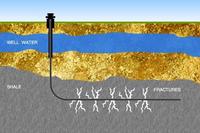-
MIT researchers develop method to help communities plan for climate risk
As the devastation left by Sandy continues to reverberate, decision-makers at every level are asking: How can we be better prepared? MIT researchers developed a tool to assess regional risks of climate change and potential impacts on local infrastructure and planning; the tool helps policymakers, city planners, and others see the possible local effects of climate change, such as long-term temperature and precipitation changes, allowing local planners to evaluate risks, and how these risks could shape crops, roads, and energy infrastructure
-
-
Building material of millennium: Autoclave Aerated Concrete

Although widespread rebuilding in the hard-hit New York metro region from Hurricane Sandy has not yet begun, New Jersey Institute of Technology (NJIT) scientists say when the hammers start swinging, it is time to look at autoclaved aerated concrete; the material, best known as AAC, has been heralded as the building material of the new millennium
-
-
Inflatable giant plugs could have saved NYC subway system

Inflatable plugs being developed with funding from DHS, could have saved some of New York’s subway and highway tunnels from flooding during Hurricane Sandy, according to the developers of the plugs; DHS successfully tested a plug earlier this year, using a 16-foot diameter prototype to hold back pressurized water at a test tunnel in Morgantown, West Virginia; the idea was originally intended to protect tunnels from terrorist attacks
-
-
Dutch flood-protection may be suitable for New York, other East Coast cities

Megastorms and disasters are not going to continue to be once in a lifetime storms, but instead become more of an annual occurrence; experts say that the combination of more frequent megastorms and rising sea levels across the east coast would forcemany cities to get serious about flood protection
-
-
Long-term sea level rise could cost Washington, D.C. billions
New study projects that the city of Washington, D.C., and federal property in the city, could suffer billions of dollars in damage if sea level rise as a result of global warming increases over the next century. Potential for significant damage will be even greater in the event of extreme weather like Hurricane Sandy
-
-
Indian monsoon failure more frequent with warming
Global warming could cause frequent and severe failures of the Indian summer monsoon in the next two centuries, new research suggests; the effects of these unprecedented changes would be extremely detrimental to India’s economy which relies heavily on the monsoon season to bring fresh water to the farmlands
-
-
Nuclear energy facilities proved themselves resilience during Hurricane Sandy

There are thirty-four nuclear energy facilities in the area hit by Hurricane Sandy; all of them have responded well and safely to the powerful storm; the industry says that careful planning and preparations days in advance of the storm paid off at all of these facilities
-
-
Hurricane Sandy offered support for reliance on nuclear power
A Scientific American writer is impressed with the way nuclear power facilities were able safely to withstand the wrath of Hurricane Sandy; the lesson he draws from this experience: “Global warming is increasing the probability and destructiveness of extreme weather events like Sandy. (I don’t see the point of dithering over this claim any more.) The last thing we should do in the face of this threat is abandon nuclear energy. If anything, we need more nuclear power, not less, to curb global warming”
-
-
Fracking: fact vs. fiction

In communities across the United States, people are hearing more and more about a controversial oil and gas extraction technique called hydraulic fracturing — aka, hydro-fracking; controversies pivot on some basic questions: Can hydro-fracking contaminate domestic wells? Does it cause earthquakes? How can we know? What can be done about these things if they are true? Experts making presentations at the Geological Society of America (GSA) meeting this week in Charlotte, North Carolina, will address these and related critical questions
-
-
Study supports move toward common U.S. math standards
A new study analyzing the previous math standards of each state provides strong support for adoption of common standards, which U.S. students desperately need to keep pace with their counterparts around the globe
-
-
Obama, Romney differ on major homeland security issues

Tomorrow, Tuesday 6 November, American voters will choose between Barack Obama and Mitt Romney as the next president of the United States; the state of the U.S. economy and the best ways to reduce unemployment and increase the pace of economic growth were at the center of the campaign, leaving little room for other issues. Homeland security issues, in particular, played little, if any, role in the campaign or in the three debates between the presidential candidates and the debate between the vice-presidential candidates; still, if we examine the policy proposals each candidate has made, and also examine the details of policies posted on his Web sites, the differences between the candidates’ approaches on three major homeland security issues – immigration, cybersecurity, and infrastructure – are considerable
-
-
States, localities to assume more responsibilities for rebuilding U.S. aging infrastructure
Infrastructure in the United States is in bad shape; Maryland needs more than $100 million a year for its bridges; Virginia needs $125 million per year for roads that need repaving; Washington’s failure to create a long-term funding plan to repair the nation’s infrastructure is forcing state and local governments to fill the void in federal funding
-
-
Sandy in perspective
Hurricane Sandy has left death and destruction in its path, and it broke a few records, but there were worse hurricanes; since 1900, 242 hurricanes have hit the United States; if Sandy causes $20 billion in damage, in 2012 dollars, it would rank as the seventeenth most damaging hurricane or tropical storm out of these 242; the Great Miami Hurricane of 1926 tops the list; Hurricane Katrina ranks fourth; from August 1954 through August 1955, the East Coast saw three different storms make landfall — Carol, Hazel, and Diane; each, in 2012, would have caused about twice as much damage as Sandy
-
-
Experts: German nuclear exit offers economic, environmental benefits
Following the accident at the Fukushima Daiichi Nuclear Power Station in 2011, the German government took the nation’s eight oldest reactors offline immediately and passed legislation which will close the last nuclear power plant by 2022; this nuclear phase-out had overwhelming political support in Germany; elsewhere, many saw it as “panic politics”; a new collection of studies shows that the nuclear shutdown and an accompanying move toward renewable energy are already yielding measurable economic and environmental benefits
-
-
U.K. govt. awards £37.1 million for civilian nuclear research
The U.K. Department for Business, Innovation and Skills has announced an award of 37.1 million pounds to the University of Sheffield’s Nuclear Advanced Manufacturing Research Center (Nuclear AMRC), which are working in partnership with Rolls-Royce as the lead company for the U.K. nuclear supply chain
-
More headlines
The long view
Factories First: Winning the Drone War Before It Starts
Wars are won by factories before they are won on the battlefield,Martin C. Feldmann writes, noting that the United States lacks the manufacturing depth for the coming drone age. Rectifying this situation “will take far more than procurement tweaks,” Feldmann writes. “It demands a national-level, wartime-scale industrial mobilization.”
Trump Is Fast-Tracking New Coal Mines — Even When They Don’t Make Economic Sense
By Katie Myers
In Appalachian Tennessee, mines shut down and couldn’t pay their debts. Now a new one is opening under the guise of an “energy emergency.”
Smaller Nuclear Reactors Spark Renewed Interest in a Once-Shunned Energy Source
By David Montgomery
In the past two years, half the states have taken action to promote nuclear power, from creating nuclear task forces to integrating nuclear into long-term energy plans.
